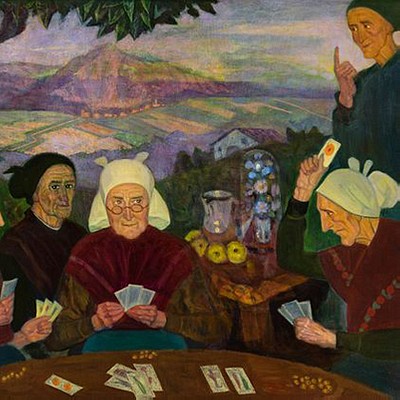IGNACIO DÍAZ OLANO (Vitoria, 1860 - 1936). "Las langosteras", ca.1925. Oil on canvas.
Lot 86
About Seller
Setdart Auction House
Carrer Aragó 346
Barcelona
Spain
Setdart Subastas was born in 2004 and is currently the first online art auction in Spain with solidity, prestige and reliability guaranteed by our more than 60,000 users. Setdart has a young, dynamic and enterprising team ready to successfully manage the purchase and sale of art works through custom...Read more
Estimate:
EUR€18,000 - EUR€20,000
$18,750 - $20,833.33
Absentee vs Live bid
Two ways to bid:
- Leave a max absentee bid and the platform will bid on your behalf up to your maximum bid during the live auction.
- Bid live during the auction and your bids will be submitted real-time to the auctioneer.
Bid Increments
| Price | Bid Increment |
|---|---|
| EUR€0 | EUR€10 |
| EUR€200 | EUR€25 |
| EUR€500 | EUR€50 |
| EUR€1,000 | EUR€100 |
| EUR€3,000 | EUR€200 |
| EUR€5,000 | EUR€500 |
| EUR€10,000 | EUR€1,000 |
| EUR€20,000 | EUR€2,000 |
| EUR€50,000 | EUR€5,000 |
About Auction
By Setdart Auction House
Dec 14, 2021
Set Reminder
2021-12-14 08:00:00
2021-12-14 08:00:00
America/New_York
Bidsquare
Bidsquare : 19th & 20th Century Fine Art
https://www.bidsquare.com/auctions/setdart-auction-house/19th-20th-century-fine-art-7992
Gaudi, Sorolla, Torres Garcia, Maclet, TSUGUHARU FOUJITA, Benjamin Palencia Setdart Auction House sofia@setdart.com
Gaudi, Sorolla, Torres Garcia, Maclet, TSUGUHARU FOUJITA, Benjamin Palencia Setdart Auction House sofia@setdart.com
- Lot Description
IGNACIO DÍAZ OLANO (Vitoria, 1860 - 1936). "Las langosteras", ca.1925. Oil on canvas. Signed in the lower right corner. Work reproduced in color in "Basque painters and sculptors of yesterday, today and tomorrow", page 307. Measurements: 100 x 90 cm; 120 x 110 cm (frame). The production of Ignacio Díaz Olano is inscribed within the framework of the rise of regionalism in Spain in the second half of the 19th century and the first third of the 20th century. In this canvas, Olano offers us a realistic portrait of local customs, centered on the representation of two lobsterwomen from the Basque Country. The two women converse relaxedly beside the estuary of the village, while the basket with the lobsters caught during the day rests next to them. The clothes they both wear, with clogs and wide aprons, as well as the regional hairstyles they wear, denote the painter's search to reflect the types and customs of the Basque Country, which make it different and unique. In this boom of regionalist art, painters like Olano vindicated their own roots and, above all, the traditions and forms of dress, at a time when customs were threatened by the notable growth of urban areas and the imposition of new fashions brought from outside. Art, fundamentally in its pictorial aspect, thus became in a certain way a vehicle of expression capable of making regional peculiarities known to the rest of the nation. Ignacio Díaz began his training in Vitoria, and then studied in Barcelona, with a scholarship from the Vitoria City Council, between 1876 and 1880. In Barcelona his teacher was Gustavo Bacarisas, and he studied at the School of Fine Arts. After finishing his apprenticeship he returned to his native city, where he collaborated for some time in the weekly magazine "El Danzarín", signing his drawings with the pseudonym "Galop". Then, in 1890, he moved to Paris, where he spent four years studying anatomical drawing. He also worked in the French capital as a set designer for the Opera House. In 1894 he went to Rome with his friend Felipe Arrieta. After two years in Italy, in 1896 he took up permanent residence in Vitoria. Between 1890 and 1925 Díaz participated in multiple editions of the National Exhibitions of Fine Arts, obtaining a bronze medal in 1895 and a silver medal in 1899 and 1901. He taught at the School of Arts and Crafts of Vitoria, and was a professor of drawing at the Institute of the same city. His work is mainly costumbrista, and is impregnated by a great naturalism. He was also a great portraitist, having also cultivated still life and landscape. In 1963 the Provincial Council of Alava held an anthological exhibition of his work in his honor, exhibiting one hundred and fifty-eight works. The critic Mario Ángel Marrodán stated: "The ardent and powerful lyricism of his painting is the result of the fusion or confrontation of man with his time, of the painter and his environment, or of the artistic reality between rustic and wild from which he has extracted the new fruits of the work of art". Ignacio Díaz is currently represented in the Prado Museum (his work is on deposit in the Fine Arts Museum of Asturias), the Fine Arts Museums of Vitoria and Asturias, the Provincial Museum of Alava, the City Hall and the School of Arts and Crafts of Vitoria, the Caja Vital Foundation and the collection of the Bank of Vitoria, as well as in numerous private collections.
- Shipping Info
-
In-house shipping available. Please inquire at admin@setdart.com.
-
- Buyer's Premium



 EUR
EUR CAD
CAD AUD
AUD GBP
GBP MXN
MXN HKD
HKD CNY
CNY MYR
MYR SEK
SEK SGD
SGD CHF
CHF THB
THB

















